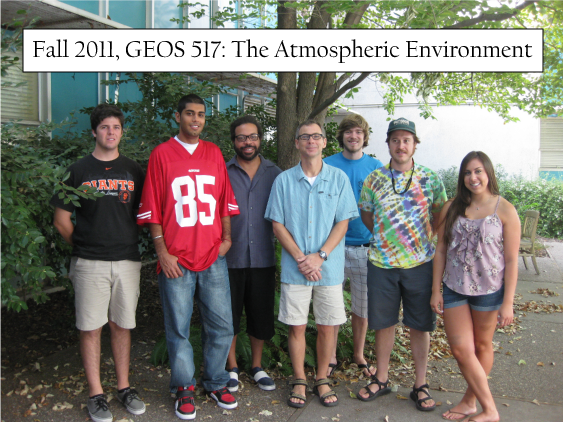
This senior level environmental science course will examine the main constituents of the atmosphere,
how they effect the earth's radiation budget, vertical structure of the atmosphere, circulation, and transport.
We are not following a textbook. Students are responsible for learning from the lectures and notes.
However, we are reading and being quized on parts of the IPCC's
2005 Physical Basis for Climate Change.
Fall 2011 Meeting times: MWF, 10:00 - 10:50 AM. Location: Physical Science Building 119
Click here for a PDF of the Syllabus.
Lectures
8/22 - Intro
8/24 - Air, aerosols, hydrometeors
8/26 - Pollutants and greenhouse gases
8/29 - Water vapor and ozone
8/31 - Ozone and oxygen
9/2 - Nitrogen, methane
9/5 - Labor Day - Holiday
9/7 - Carbon monoxide, carbon dioxide
9/9 - Radiative forcing, Begin Planetary Heat Budget
9/12 - Quiz 1 on reading assignment: IPCC SPM. Continue Planetary Heat Budget
9/14 - Exam 1: Constituents
9/16 - Total Solar Irradiance; Continue Planetary Heat Budget
9/19 - Quiz 2 on Figs 1 and 2 from IPCC SPM. Continue Planetary Heat Budget with effects of evaporation and condensation
9/21 - Radiative forcing, Greenhouse effect
9/23 - Begin vertical structure of the atmosphere; troposphere; tropopause
9/26 - Layers of the middle and upper atmosphere; begin vertical stability
9/28 - Continue vertical stability; atmospheric boundary layer; turbulence
9/30 - Turbulent vs. laminar flow; wind shear; convective boundary layer (CBL)/mixed layer
10/3 - Quiz 3 on major layers. Lecture on CBL; entrainment zone; surface layer; Ekman boundary layer
10/5 - Guest Speaker:
Dr. Andreas Held, from University of Bayreuth, Germany, on Atmospheric Aerosols
10/7 - Climate feedbacks; Begin clouds
10/10 - Continue clouds
10/12 - Quiz 4 on Fig 3 of IPCC SPM. Lecture: Radiative effect of clouds on earth's heat budget
10/14 - Complete radiative effect of clouds on earth's heat budget; direct & indirect effects.
10/17 - No class. Prepare for exam.
10/19 - No class. Prepare for exam.
10/21 - Exam 2: Planetary heat budget, greenhouse effect, radiative forcing, vertical structure of the atmosphere, clouds, feedbacks
10/24 - Hydrostatic balance and equation; Begin surface of earth: ocean
10/26 - Continue surface of earth: ice, land. Begin surface energy balance.
10/28 - Field trip to Lidar at University farm.
10/31 - Surface energy balance during sunny days over land. Emissivity. Begin surface energy balance at night.
11/2 - Finish surface energy balance at night. Define: conduction, convection, diffusion. Review laws of thermo.
11/4 - Global distribution of insolation. Begin general circulation.
11/7 - Discussion of term paper assignment.
11/9 - Quiz 5 on components of the general circ. Lecture: Pressure gradient, Hadley cell, ITCZ, Thermally direct and indirect circulations.
11/11 - Veterans Day - no class.
11/14 - Airmasses, Ferrel and polar cells
11/16 - Trade winds, trade wind BL, jet streams, LLJs
11/18 - Exam 3: Surface energy budget and general circulation
11/21 - Thanksgiving break - no class
11/23 - Thanksgiving break - no class
11/25 - Thanksgiving break - no class
11/28 - Inertial and rotating reference frames; Coriolis Force; Coriolis parameter; f-plane approximation
11/30 - Kolmogorov scale, Microscale, Mesoscale, Synoptic scale, Planetary scale, Lagrangian, Eularian
12/2 - Geostrophic wind, Barotropy, Baroclinity
12/5 - Guest Speaker: Dr. Christoph Senff, NOAA-CSD/CIRES, Boulder, CO: Air quality
12/7 - Student presentations on hazardous atmospheric releases:
Alan Rhoades - Mt. Pinatubo, Phillipines, volcanic eruption, Paper
Brendon Phillips - Sverdlovsk, Russia, anthrax release, Paper
Rajmir Rai - Bhopal, India, methyl isocyanate release, Paper
Frank Rebelo - Graniteville, SC, USA, chlorine release, Paper
12/9 - Review for comprehensive Final Exam
12/14 - Final Exam
Dr. Mayor's page
CSU Chico Atmospheric Lidar Research Group
This page updated 10/4/2011.
